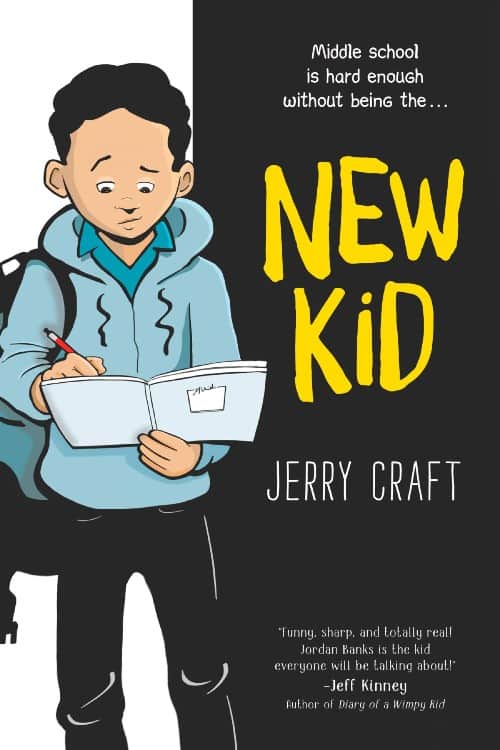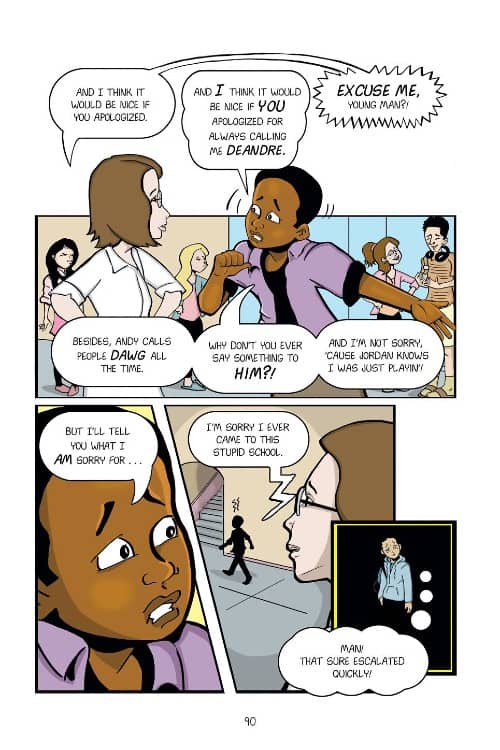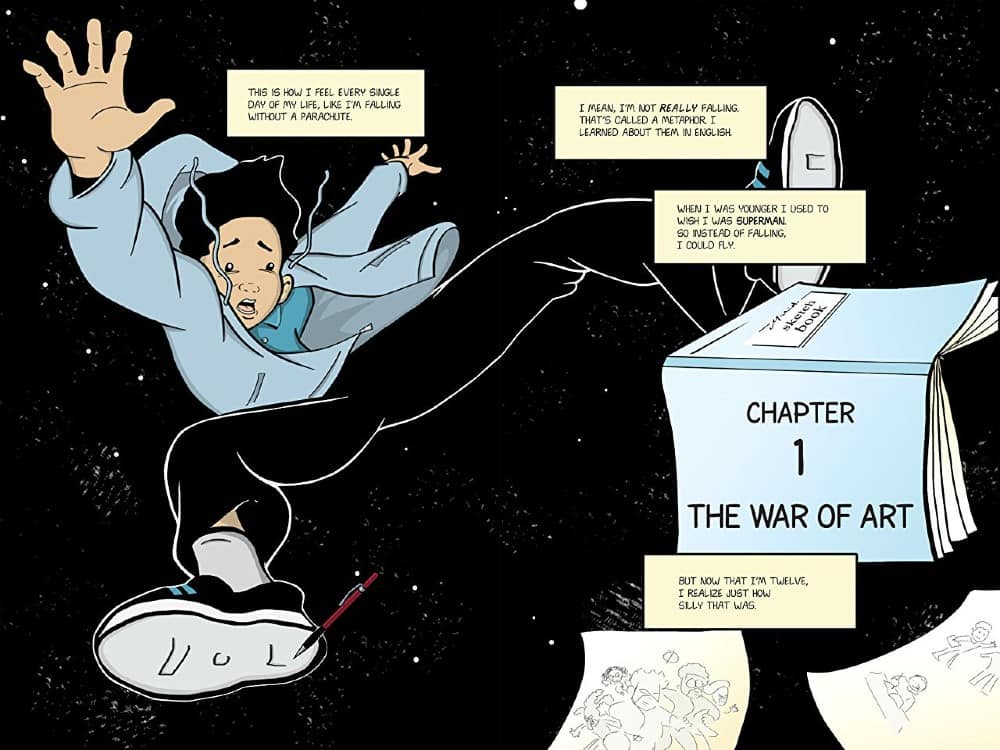Black History Month Graphic Novel Spotlight: Jerry Craft’s New Kid, the Newbery Medal Winner
Somewhere along the way in comics and graphic novels, superheroes stopped being for kids. At the same time, we’ve seen an increase in graphic novels of all kinds for kids. Books like American-Born Chinese, Bone, and Amulet show a wide variety of stories. Sure, comics for grown-ups also have a great variety, but the non-superhero stories aren’t embraced as much as kids embrace the plethora of stories available to them. And now, we’ve come to a point where we can really say graphic novels have “arrived.” Jerry Craft’s New Kid became the first graphic novel to win a Newbery Medal. The significance of that accomplishment can’t be understated. And New Kid more than deserved the award.
Jerry Craft’s New Kid Brilliantly Breaks Young Black Man Stereotype

(Image: Jerry Craft’s New Kid, Quill Tree Books)
Throughout Jerry Craft’s New Kid, there’s a running joke about the coming-of-age stories written for young while males and young black males. The books for the white boys have titles like “The Magic of the Magical Magicon: A Magical Adventure,” in which “Prince Aimii leaves his dull life to slay a dragon, rescue Princess Brea, and prove to his father that one day he’ll make a worthy king.” And what do the young black boys have? “The Mean Streets of South Uptown,” where “After moving to his third city in three years, DaQuell “Scooter” Jackson must decide if he will pursue his dreams of being in the NBA or join a notorious gang.” Magicon has a royal family where Uptown has a broken home. Critics call Magicon “a triumph” while they praise Uptown for being “gritty.”
New Kid is Jerry Craft’s antithesis to these stories. Our hero, Jordan Banks, comes from a middle-class family—not a broken home, his mother and father are both there. He’s not trying to decide between sports and crime. His biggest crisis is that he wants to go to art school while his mother wants him to go to a fancy private school. Education wasn’t even a choice in Uptown. Jordan is a smart, awkward, artsy kid. He’s far from any black stereotype. In fact, none of Jerry Craft’s characters in New Kid fit any stereotype. Even the bully is not as simple as how bullies are usually portrayed (also from broken homes and “acting out”). Jordan’s a multi-layered, complicated kid, but what makes him special is that he isn’t special. At least, not in the way people say that “different” is “special.” He’s a kid.
Expertly Exploring Economic in an Essential Graphic Novel

(Image: Jerry Craft’s New Kid, Quill Tree Books)
Riverdale Academy Day School is a strange place. Most of the students have parents in the top 1% of wealthy Americans. One kid even spends New Year’s Eve in a space shuttle. But the school also offers grants and financial aid to gifted students whose parents can’t afford the staggering tuition. So, it’s not surprising that there’s an underlying issue of class warfare at play throughout the book. One of Jerry Craft’s most brilliant skills, however, is that there’s no theme in the book that dominates too much, or feels forced.
We see some kids, like Jordan, immediately looked down upon for being black and not-rich. Meanwhile, one of his white classmates tries desperately to hide the fact that he also needs financial aid. And then there’s the teacher who keeps assuming all of her black students must be poor and from broken homes, even though one those student’s father runs a Fortune 500 company. But there’s not a moment in the book where it becomes a strict “rich vs. poor” story. These kids interact, they’re friends with each other, and they fight for different reasons.
Jerry Craft’s Portrayal of Race Issues in New Kid is Critical Without Being Condescending

(Image: Jerry Craft’s New Kid, Quill Tree Books)
As refreshing as his take on economic issues is, Jerry Craft’s dealing with race issues in New Kid is even more remarkable. Race can’t take a backseat here. It can’t be too subtle, because it is such a prevalent issue for so many young black students in America. From the teacher mentioned above, who spends an entire year calling her black students by the wrong names, to the white bully who calls one of his black classmates “Oreo,” and teases a Nicaraguan student about tacos because he thinks he’s Mexican.
One of the most remarkable and tragic skills Jordan has is the ability to blend into almost any situation. In his journal, he explains how he slowly changes his appearance from bus stop to bus stop until he gets to RADS. He first has to take off sunglasses, then pack his hoodie, then sit a certain way—all of this to make sure he doesn’t look to weak or too threatening deepening on his location. Once at school, he’s conflicted about how much he should fit in, and how much he wants to be himself…and he isn’t even entirely sure what that means either way. After all, this is a coming-of-age story. He goes home, plays with his friends in his neighborhood, who tease him—playfully—for going to private school. At the private school, the bully and his friends call him “little G.”
But what does Jordan want? Really, he just wants to be. He’s not after some grand change in the school or his neighborhood. He cares about making a few friends. Jordan is nervous about girls. He’s the new kid, but Jerry Craft’s writing shows him as an evolving kid. And he’s about to start high school, after all.
Alexandra, the Puppet Girl, is Jerry Craft’s Best Supporting Character in New Kid

Hard to miss her. (Image: Jerry Craft’s New Kid, Quill Tree Books)
If anyone mentions this book and doesn’t bring up Alexandra, then they failed at recognizing what makes this book so great. Jordan is a lovable kid, and he’s reflected in the friends he makes and his kindness to others. One of those friends he kind of accidentally makes is the school’s “weird girl,” Alexandra. For reasons we don’t know until later in the story, she insists on wearing a sock puppet on one of her hands. Obviously, there’s some mental distress happening with her. But even though Jordan knows people think that she’s weird, and he’s reluctant, he doesn’t push her away either. She is weird, and Jordan doesn’t pretend that she isn’t. Sure, her puppet voices might be a little annoying, but all of Jerry Craft’s characters in New Kid have some kind of quirk.
Whenever Alexandra pops up, the book gets a little more delightful. She also might or might not be Jordan’s first crush. Craft plays this very ambiguously. He’s afraid that she’ll kiss him because he’s scared of being in any relationship with a girl. He gets nervous just maintaining friendships. A girlfriend? Maybe Jerry Craft’s love for his character made him spare this new kid from an even more significant new experience than just going to a new school. Still …they’d be adorable together.
Jerry Craft’s Art and Creativity Brings New Kid to Life in Unique Ways

(Image: Jerry Craft’s New Kid, Quill Tree Books)
The art is fantastic. It’s a style perfect for a kid’s graphic novel, and uses inks and colors in a way that stands out without being too dynamic. It all feels smooth from page to page. Every so often, he exaggerates the appearance of a character, which is just a great reminder of how graphic novels can express meaning in ways a prose novel can’t.
But best of all is Jerry Craft’s humor throughout New Kid. And that’s best seen in his chapter titles. Each chapter title references a piece of pop culture. In some ways, Craft is throwing some jokes in for parents. One chapter is called “The Socky Horror Picture Show,” another is “Right Club.” And then there’s the one that felt completely out of left field, “Cleats, Play, Gloves.” It took me a second of repeating it a few times to get it: “Eat, Pray, Love.” Craft managed to fit in a reference to a memoir of a woman’s white privilege and cultural appropriation into a book about a young black man trying to define his own identity. Dude…well played. And that’s definitely for the parents. What kid is going to get that reference?
But kids will get his other references. “Jordan Banks: The Non-Winter Soldier,” or “The Hungry Games: Stop Mocking J,” and my personal favorite: “The Road to Riverdale: There and Back Again.” Sure, “Rad Men” will make older audiences giggle a little, but “The Farce Awakens” will resonate with readers of all ages.
The Importance of the Newbery Medal for New Kid can’t Be Understated
In 1992, Art Siegelman won a Pulitzer for his graphic bio Maus. It was the first graphic novel to win an award outside of comics award, or outside of sci-fi/fantasy. And even then, it wouldn’t be until the 2000s that graphic novels would start winning more general literature awards, or at least make it to shortlists and long lists. Nick Drsano’s Sabrina was the first graphic novel to make it to the Man-Booker Award shortlist. All of those accomplishments are vastly important; however, Jerry Craft’s Newbery Medal win for New Kid is the most important since Spiegelman’s Maus earned him a Pulitzer.
The Newbery Medal is one of the few literary awards where people outside of the industry and genre instantly recognize it. People collect the Newbery winners each year, as some do with the Hugo, Man-Booker, and Pulitzers. But the Newbery is distinctive for its tendency to see the changing dynamics in culture applied to children’s literature. Most Newbery winners, especially recent ones, do a little more than simply tell great stories. They tap into a zeitgeist of changing perspectives in American culture, and how children are embracing those changes. Jerry Craft’s New Kid fits right in with recent winners such as Merci Suárez Changes Gears, by Meg Medina and Hello, Universe by Erin Entrada Kelly. Of course, he’s also now in the same club as Neil Gaiman and Lois Lowry. And it is well-deserved.
(Featured Image: Jerry Craft’s New Kid, Quill Tree Books)
Black History Month Graphic Novel Spotlight: Jerry Craft’s New Kid, the Newbery Medal Winner
Roman Colombo
from Comic Years https://ift.tt/32bqkNg
https://ift.tt/32o5pXH

0 comments:
Post a Comment